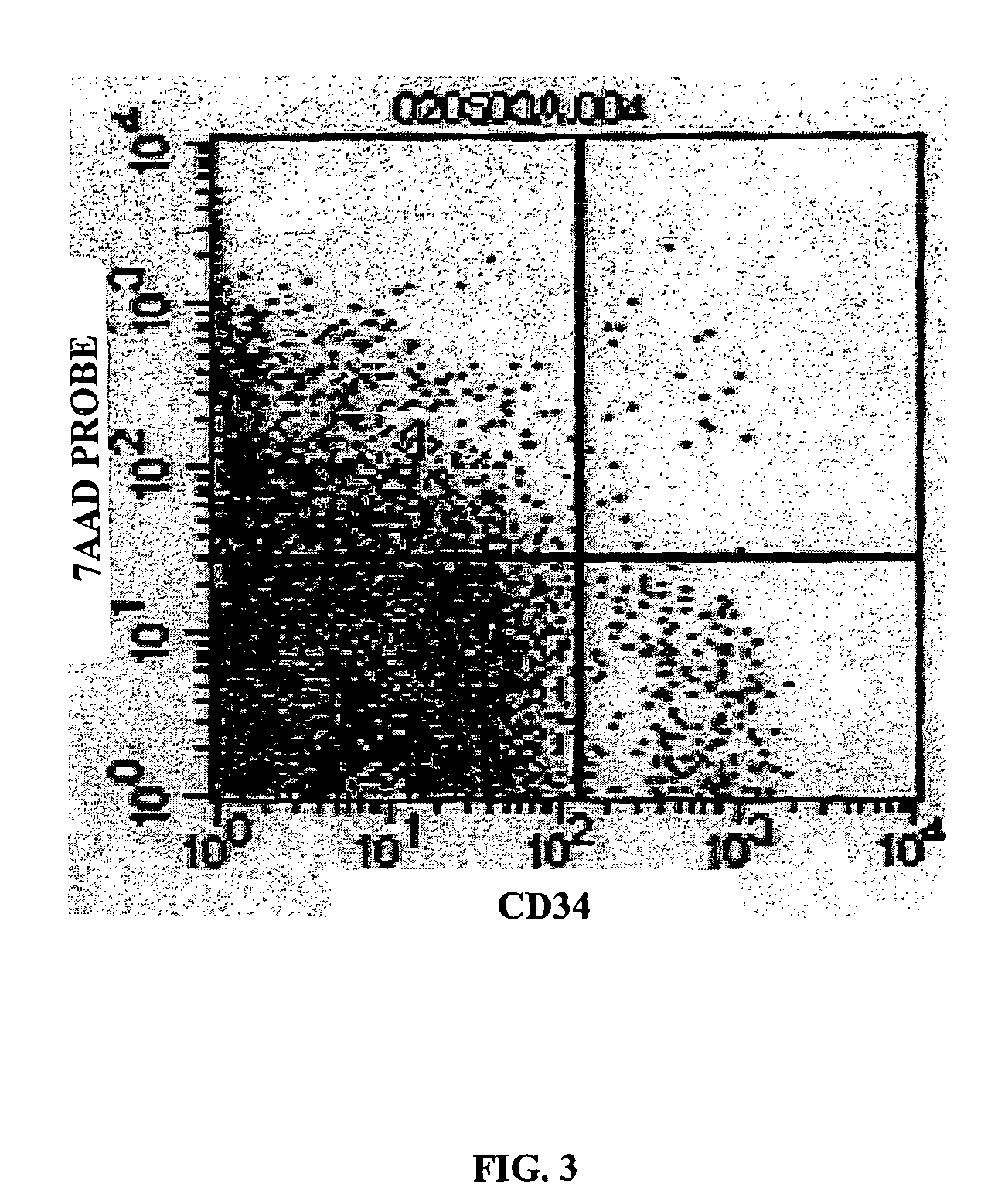Quantitative RT-PCR to AC133 to diagnose cancer and monitor angiogenic activity in a cell sample
a cell sample and angiogenic activity technology, applied in the field of cancer biology and nucleic acid biochemistry, can solve the problems of many techniques presently in use that are impractical, invasive, uneconomical, etc., and achieve the limitations of mvd, many practical and theoretical limitations for clinical use, and the clinical results of a number of lead anti-angiogenic agents
- Summary
- Abstract
- Description
- Claims
- Application Information
AI Technical Summary
Problems solved by technology
Method used
Image
Examples
example 1
Materials and Methods
[0112]Quantitative PCR™ of AC133. mRNA were prepared from 1×106 human peripheral mononuclear cells and extracted using oligo dT. A number of specific 3′ and 5′ primers for AC133 were designed based on the gene bank sequence query on published cDNA of AC133 (Yin et al., 1997). Through screening, highly specific 3′ and 5′ primers were selected. All PCR™ for AC133 was performed under standard protocols with amplification for 30 cycles and with β-actin as an internal control. The sensitivity of the assay was evaluated by serial dilution of human umbilical cord endothelial cells in the U-937 cell line or purified CD34+ cells in human mononuclear peripheral blood. The detection limit of this procedure was 1 EPC per 1×106 PMNC and specificity is more than 90%.
[0113]Measurement of CECs and EPCs. Measurement of cells in the peripheral blood is enumerated by three-color flow cytometry using a panel of monoclonal antibodies that react with CD45 (to exclude hematopoietic ce...
example 2
Results
[0114]RT-PCR was performed in three patients with CRC, as well as two healthy volunteers to analyze AC133 expression. The control was from enriched peripheral mononuclear progenitors / stem cells prepared for bone marrow transplant with CD34+ at 1×106 MNC. It is interesting to note that both patients 1 and 2 had metastatic disease, whereas patient 3 had the primary tumor resected approximately 4 wk previously, and showed lower level AC133 as well as plasma VEGF level (FIG. 1). The data indicates decrease in tumor burden (surgery) is associated with decreased peripheral blood EPCs.
[0115]Serum VEGF and other angiogenic cytokines. Cytokines and VEGF were measured in the plasma of the human subjects by using commercial ELISA kits for VEGF and others cytokines (R&D, Minneapolis, Minn.) as described elsewhere (Shi et al., 2001; Shi et al., 2000).
[0116]ELISA assays were conducted for VEGF and basic FGF in the plasma samples from the three CRC patients and two healthy normal volunteers...
example 3
RT-PCR and Quantitative PCR™ (Q-RT-PCR) Analysis of AC133
[0117]Study population. Fifty-eight CRC patients were enrolled in this study. Patients with underlying active wound, inflammation, infection, surgery <4 weeks, recent heart attack or stroke, or limb ischemia were not eligible. All patients were required to sign an informed consent before 30 cc of peripheral blood is collected.
[0118]CEP positive control cells. Cytokine mobilized CD34+ PBMNC from healthy volunteers were used in this experiment. The frozen CD34+ enriched peripheral blood mononuclear cells preparations were thawed in 37° C. water bath. The red blood cells were lysed with RBC lysates. PBMNC cells were then incubated with 1.5 μL of FITC-labeled high-affinity, nonneutralizing MoAbs to a phycoerythrin (PE; red fluorescence)-labeled anti-CD34 antibody (Becton Dickinson, San Jose, Calif.) for 20 minutes and the cells were washed with PBS. The number of positive cells was compared to immunoglobulin G isotype control (FIT...
PUM
| Property | Measurement | Unit |
|---|---|---|
| temperatures | aaaaa | aaaaa |
| temperatures | aaaaa | aaaaa |
| temperatures | aaaaa | aaaaa |
Abstract
Description
Claims
Application Information
 Login to View More
Login to View More - R&D
- Intellectual Property
- Life Sciences
- Materials
- Tech Scout
- Unparalleled Data Quality
- Higher Quality Content
- 60% Fewer Hallucinations
Browse by: Latest US Patents, China's latest patents, Technical Efficacy Thesaurus, Application Domain, Technology Topic, Popular Technical Reports.
© 2025 PatSnap. All rights reserved.Legal|Privacy policy|Modern Slavery Act Transparency Statement|Sitemap|About US| Contact US: help@patsnap.com



